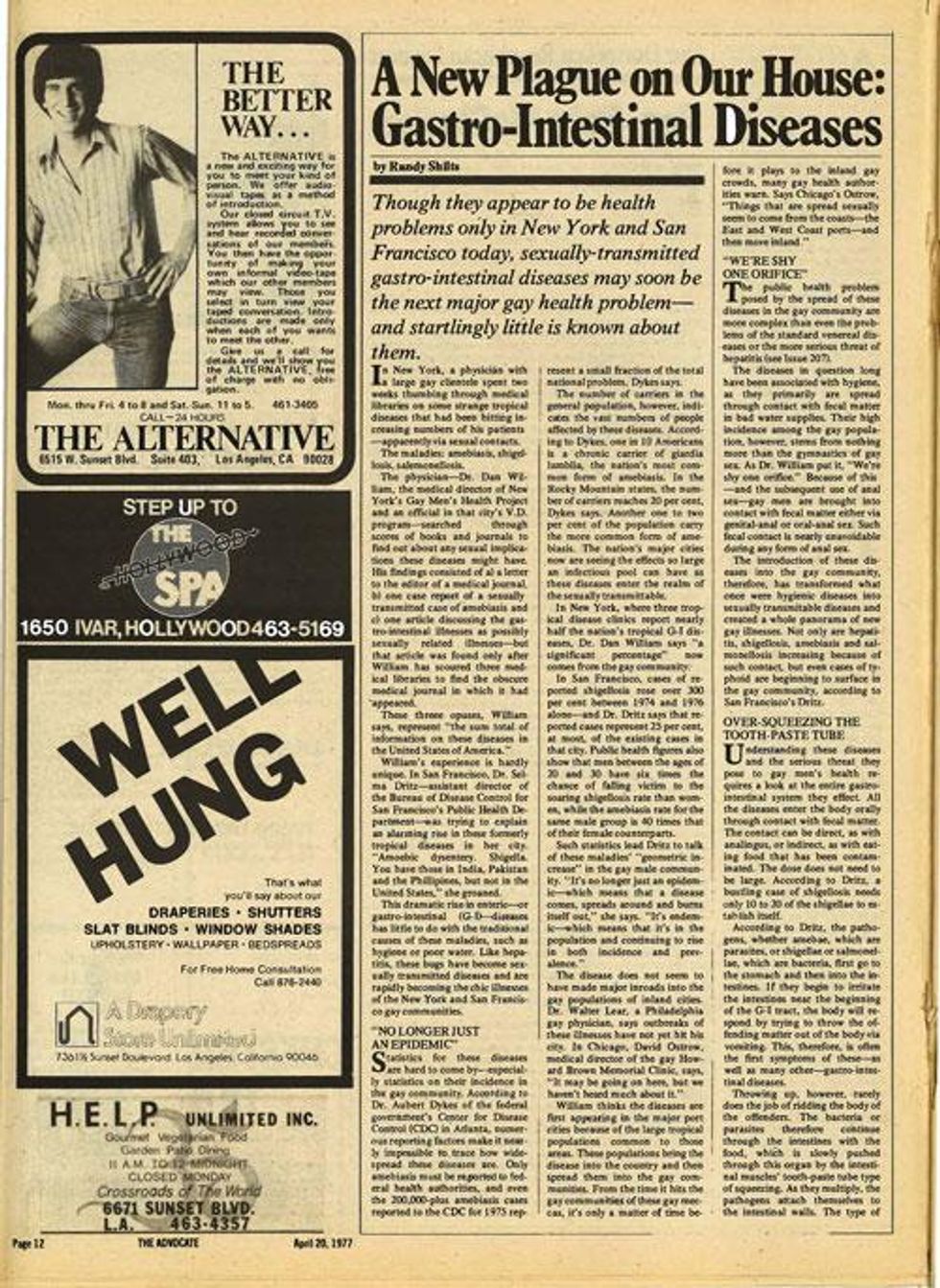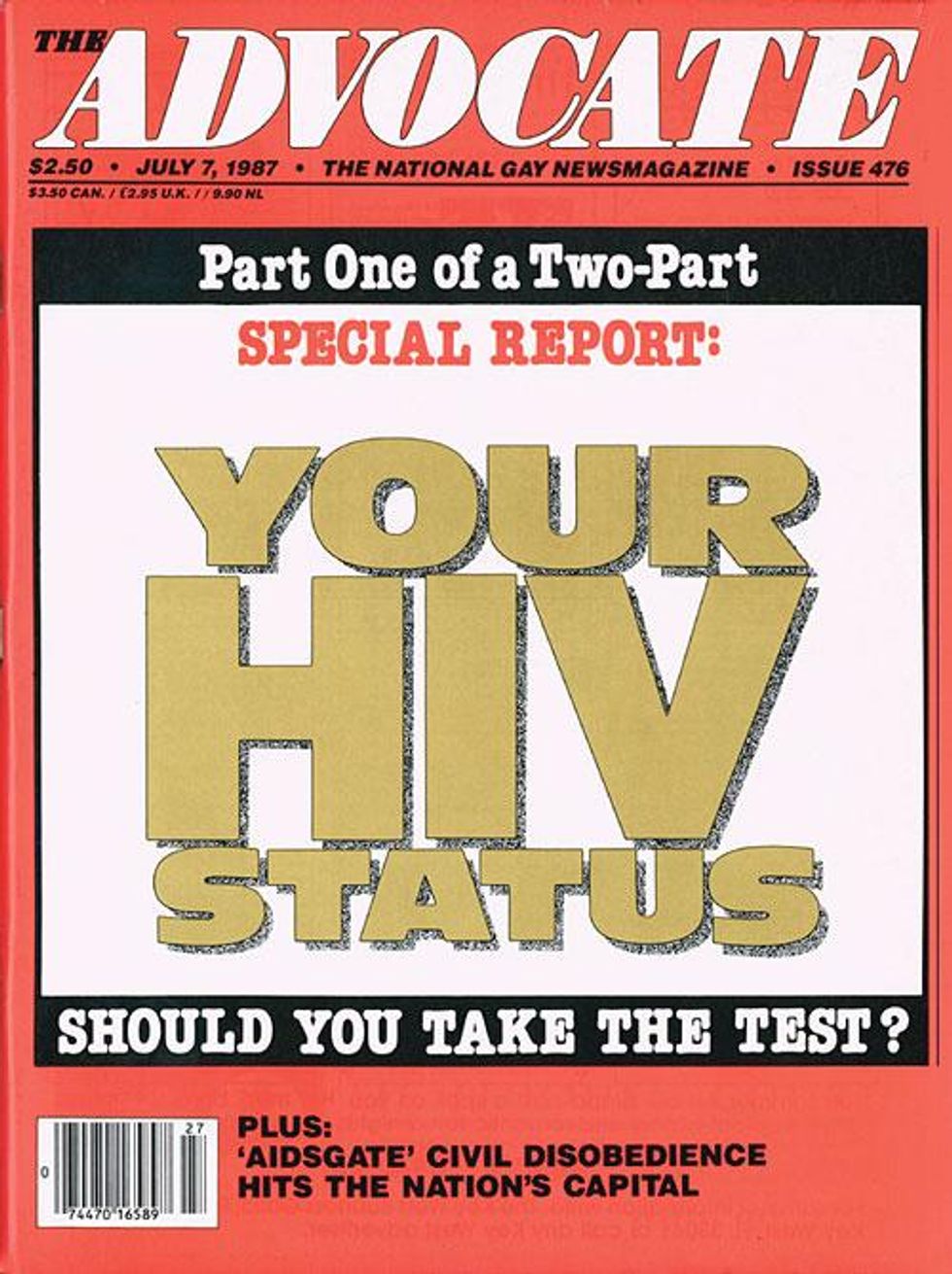
A REFLECTION OF 50 YEARS
As
The Advocate marks its 50 Anniversary, let's take a look back at 50 years of groundbreaking journalism from a magazine at the forefront of the HIV and AIDS crisis.
1959

The first human tissue samples have been verified to have HIV from a man taken this year in what was once Africa's Belgian Congo.
1966
Genetic studies suggest HIV first arrived in the Americas around this time. One now recognized infection occurs in Haiti.1967

The Advocate launches as The Los Angeles Advocate newsletter, after the Black Cat protests.
1969
A St. Louis teenager, Robert Rayford, dies of a strange illness. Researchers later test his samples and determine he was HIV-positive.1977

April 20th.
The Advocate runs a news story by Randy Shilts, titled "A New Plague on Our House: Gastro-Intestinal Disease." The 1977 article noted that several "rare, tropical diseases" were becoming endemic to gay male communities in major port cities like New York and San Francisco. This same year, a San Francisco sex worker gives birth to the first of three children who are later determined to have passed away from AIDS-related complications.
1980
San Francisco resident Ken Horne, becomes the first U.S. resident officially diagnosed with what we would later call AIDS.1982
 The Advocate
The Advocate publishes its first major article on AIDS (then known as GRID), asking, in the cover story, "Is the Urban Gay Male Lifestyle Hazardous to Your Health?" The term "AIDS" is coined by the CDC later that year.
1982
The Gay Men's Health Crisis (GMHC) is officially founded by Nathan Fain, Larry Kramer, Lawrence D. Mass, Paul Popham, Paul Rapoport, and Edmund White in New York City. The group's first service was a hotline, which began as an answering machine in the apartment of a volunteer, Rodger McFarlane, who later became the organization's second executive director. On the first night, 100 calls were received.1983

French researchers isolate the human immunodeficiency virus and determine it is the primary cause of AIDS. U.S. researchers report similar findings the following year. The Advocate puts the word "AIDS" on the cover for the first time. The article, "Coping With a Crisis," asked scientists, doctors, and politicians what they were doing to halt the now seemingly unstoppable epidemic.
1983
Dr. Mathilde Krim founded the AIDS Medical Foundation (AMF), the first private organization concerned with fostering and supporting AIDS research.1985
The Food and Drug Administration approves the first HIV-antibody test.President Ronald Reagan finally mentions AIDS for the first time in a public speech. The same year, the first black HIV organizations are founded, including Bebashi, Black and White Men Together, and Minority AIDS Project.1986

The federal government commits $100 million to developing HIV medications. Paul Kawata and others found the National Minority AIDS Council (NMAC)
1987

ACT UP (AIDS Coalition to Unleash Power) is founded in New York City. The first HIV drug is approved by the FDA. The NAMES Project Memorial Quilt is unveiled in Washington,D.C.
1989

In a first-person piece in
The Advocate, Lou Sullivan becomes the first out trans man to come out as HIV-positive.
1991
 The Advocate
The Advocate runs the cover story, "Cities in Crisis: How New York, San Francisco, Houston, and Los Angeles Are Losing the War on AIDS," which suggested that gay men's options are "genocide or mobilization."
1991

The Elizabeth Taylor AIDS Foundation is formed. Taylor would inspire her friend to launch the eponymous Elton John AIDS Foundation.
1992

Basketball star Magic Johnson, who came out HIV-positive the previous year appears on the cover of
The Advocate.
1994

An HIV-positive gay man, Pedro Zamora joins MTV's Real World: San Francisco and passes away just after the season concludes. Playboy Playmate Rebekka Armstrong, comes out as an HIV-positive lesbian, in
The Advocate. Former Advocate contributor Randy Shilts dies from AIDS-complications.
1995
Scientists detect HIV in a blood sample from 1959, one of the first suggestions that the virus was around before the AIDS epidemic began.1997

AIDS- related deaths decline in the U.S. by more than 40 percent due largely to highly active antiretroviral therapy. Thirty million people are now HIV-positive worldwide. "AIDS: We Asked for It," was the provocative cover line accompanying Larry Kramer's piece in The Advocate about gay men's responsibilities to stop the epidemic.
1998
 The Advocate
The Advocate's sister publication,
Plus magazine (previously HIV Plus) launches. Congress funds the Minority AIDS Initiative, investing $156 million to prevent and treat HIV among communities of color.
2000
First annual National Black HIV/AIDS Awareness Day. Clinton Administration declares HIV is a threat to national security.2002
The FDA approves the first rapid HIV test.2003
The first annual National Latino HIV/AIDS Awareness Day is celebrated. President George W. Bush launches PEPFAR (President's Emergency Plan for AIDS Relief) a five-year, $15 billion plan to combat AIDS.2005
The CDC releases guidelines for PEP (post-exposure prophylaxis). First annual National Asian and Pacific Islander HIV/AIDS Awareness Day and first National Women and Girls HIV/AIDS Awareness Day celebrated.2007

The first National Native HIV/AIDS Awareness Day celebrated. The Clinton Foundation negotiates deep price reductions for one-a-day HIV meds, making them more accessible to people with HIV.
2008

Timothy Brown, the "Berlin patient," is cured of HIV through a bone marrow transplant, becoming the first person to be functionally cured of HIV--he remains the only person who has been cured and remains virally suppressed for more than nine years.
2010

The Obama White House unveils the first National HIV/AIDS Strategy. The Affordable Care Act greatly broadens the number of people who have access to HIV care. Studies confirms PrEP works, in fact it's up to 99 percent effective in preventing the transmission of HIV.
2012

The first HIV prevention treatment known as PrEP (pre-exposure prophylaxis) is approved by the FDA. Obama signs the HIV Organ Policy Equity Act, allowing HIV-positive people to donate and receive HIV-positive organs.
2013
Since the beginning of epidemic, 78 million have become HIV-positive and 39 million have died from complications of AIDS worldwide.2015
 Transgender
Transgender Law Center's Cecilia Chung (later portrayed in the TV series When We Rise) launches the Positively Trans survey of transgender people living with HIV.
2016
The first National Transgender HIV Testing Day is celebrated. Estimates say around 56 percent of African-American trans women are living with HIV already.2016
 The Advocate
The Advocate reports on the "Perfect Storm" facing black men. Earlier in the year the CDC revealed predictions that half of all black gay and
bisexual men "will be diagnosed with HIV in their lifetime" unless things change. Later, stats argued that if nothing changed, 6 in 10 black gay and bisexual men in the United States will be HIV-positive by the time they are 40 years old.
2017
 The Advocate
The Advocate covers Dustin Lance Black's When We Rise, the miniseries about the gay rights movement that includes HIV/AIDS-related storylines. Scientists announce significant advancement toward a cure--including being able to target and kill HIV in reservoirs, and success in using the gene-editing technique CRISPR to eliminate HIV.
























Charlie Kirk DID say stoning gay people was the 'perfect law' — and these other heinous quotes